One of the most common question that we’re asked here at Gainstopia is “how do I build muscle?”.
It’s a simple question, but one where so many people don’t really understand the key components of the answer.
When I first started training years ago, I didn’t understand the answer to this question myself. For months I did the same routine in my bedroom. My routine consisted of 50 press ups, 50 squats and 50 sit ups and 20 pull ups.
As a student at the time, the typical diet was a bowl of cereal in the morning, a chocolate bar and a sandwich inbetween lectures and maybe a McDonalds or a Subway when there was still plenty of student loan left.
University life also contained A LOT of drinking with the average night out consisting of several beers, a few vodka and cokes, with a couple of multicolored shots for good measure. Naturally, being quite drunk, the usual night out typically ended with a (at the time) delicious take-a-way pizza.
But I was doing squats, sit ups AND press ups every day, why wasn’t I building muscle?
Why did I have a body that resembled Jack Black?
Why wasn’t doing press ups and sit ups every day making me look like Hugh Jackman playing Wolverine?
The answer is easy to see, when you look at all the facts:
- I drank a lot
- My sleep was poor
- I trained the same muscle groups every day
- I didn’t advance my training
- I didn’t eat much protein
- I ate lots of fast food
- My diet was carbohydrate and fat heavy
It’s a miracle that I didn’t give myself a heart attack or diabetes, having lived that lifestyle for about 18 months…
It’s easy to point out what’s wrong with such a bad diet and lifestyle, but how do you identify what’s right?
Fortunately, the basics are already out there. Pop onto any fitness based instagram and you won’t need to look long before you see the post “Train, Eat, Sleep, Repeat”.
This mantra is simple, yet potentially too simple if you’re not aware of how to train effectively, how to eat right and even that there’s more to it than simply sleeping at night.
In terms of building muscle effectively, you need three things that are absolutely essential. These are:
Progressive OverloadThe Right NutritionThe Right Recovery
Only when all these three areas are done correctly will you be able to turn your average Joe physique into something that resembles Captain America.
Are you ready? Good, now pay attention.
Welcome to muscle building 101.
1. Progressive Overload

One of the most common mistakes people make in the gym is to simply walk in, pick up the same weights they’ve been using for months and complete their standard workout.
The body is an adaptation machine:
- Have a bad posture? You’re body will adapt it’s muscles to make maintaining that posture even easier.
- Drink 5 cups of coffee a day? You’re body becomes dependent and needs coffee to function normally.
- Drink alcohol heavily? You’ve turned yourself into a heavyweight, you’ll need even more alcohol to get drunk now.
- Maybe you were in a car crash when you were younger? You’re now more likely to be scared of driving.
But it’s not all bad.. the process is adaptation is also what helps us build muscle.
In very simple terms, when you do resistance training (i.e.moving heavy objects rather than going for a run), your muscles experience micro tears. Don’t worry if this sounds a bit scary, it’s completely normal!
When you’re body realizes that specific muscle fibers have been damaged, i.e. the pectoral muscles from a heavy bench press session, it goes into a recovery mode.
During this mode, it sends in the repair crew, consisting of growth hormone and stem cells, to fix up your damaged muscle fibers. The repair crew does this using amino acids, which is just protein that’s you’ve eaten and your body has broken down into usable parts.
Your repair crew it quite clever though, it knows that the heavy bench press workout you did was really tough. So, rather than just repair your muscles, it also makes them a bit bigger and stronger too.
Therefore next time you try the same workout with the same weight, it should be a bit easier and not cause your muscles to break down as much.
Think of it in terms of a house with 1,000 small single glazed windows all around. The effect of exercising is like throwing a few stones at your house breaking a few of those windows.
When the local handy-man (or handy-lady) comes round, you ask them to fit in double-glazing instead, so that the windows are less likely to break.
After this happening a couple of times, you now have a house will double glazing on all of your windows. If you throw stones at the house, the windows simply aren’t going to break, and if the windows don’t break, why would you make them stronger?
This brings us to the critical part of this section: Progressive Overload.
Progressive overload is when this process happens over and over again, using increasingly heavy weights.
In terms of the house example, now imagine you start throwing rocks at the house, the windows inevitably break, you bring round the window fixing team and you switch to triple glazing. Next month you start firing bullets at the windows, they break, you bring round the window fixing team and you upgrade to bullet-proof-triple-glazed windows. And so on and so on.
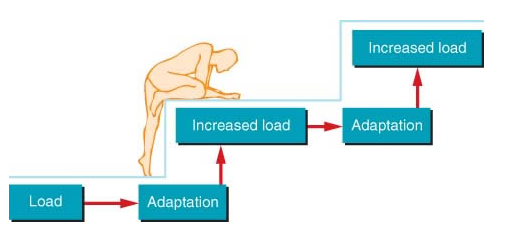

The key here is to never get comfortable. Sure, double glazing is nice, but why stick with double glazing when you could have bullet-proof-triple-glazed windows?
Back into the gym example, if you find you’re bench pressing 70kg with ease month on month, you’re not challenging your muscles, meaning there’s no muscle damage, no growth hormone, no muscle growth, simple.
If you’re at this stage whereby you find you’ve been using the same weight, for the same reps at a comfortable intensity for anything longer than 6 weeks, you need to up your game and increase the weight.
A good rule of thumb to use is that if you feel you’d be able to complete another 2 or more reps once you’ve already finished all your sets, you’re not lifting heavy enough.
But how many reps is the right amount of reps if we want to focus on building muscle?
The typical dogma goes as such:
Rep ranges of 1-6 primarily build strength.
Rep ranges of 8-12 focus on building muscle (a.k.a hypertrophy)
Rep ranges of 15+ focus on muscular endurance [1]
The range of 8-12 is said to be most effective for muscle growth for a number of reasons, firstly, you’ll typically use a heavier weight than you would use for a muscular endurance programme (15+ reps) and you’ll therefore build greater strength with a sufficient amount of volume.
Secondly, pushing out more than 6 reps is going to result in a greater release of lactic acid. This lactic acid will then cause a surge in anabolic (i.e. building) hormones in the body such as growth hormone and testosterone.
Additionally, the volume of work completed in an 8-12 rep range will also lead to more muscle damage due to an increased time under tension. Going back to our earlier house example, more broken windows = better windows installed next time, or more muscle damage = bigger muscles next time (within reason and if you get the right nutrition!) [2].
Combining this with progressive overload, one strategy is to start with a weight that you can only just about complete 3 sets of 10 with. In the second week, aim to complete 3 sets of 11, or even 12 if possible. Then, once you can complete 3 sets of 13, move the weight up by 2kg (or 2.5kg if you’re using a barbell).
You may not be able to complete a full 3 sets of 10 reps with this new weight, maybe you can only complete 3 sets of 9. That’s all good, just make sure you can do at least 7 reps or you’ll be focusing more on strength rather than muscle growth.
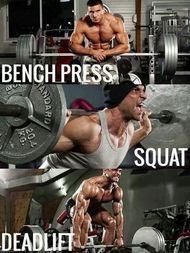
Stick with the new heavier weight and begin to build up your reps till you can do 13 with your new weight (feel free to check out your new bigger and more defined muscles out in the mirror too – you’ve earned it).
We know that you need to increase you weights over time, otherwise your body won’t adapt.
We also know that reps in the 8-12 range are your best bet for muscle growth.
But what exercises are the best for building muscle?
Lets say we want to build more impressive upper arms, so we can just do some bicep curls and some tricep extensions right?
Well, you could. But you’d really be missing out on the maximum amount of growth you could experience if you based your workouts on Compound Exercises.
Simply put, compound exercises should be the foundation of any strength or muscle building routine.
Compound exercises are movements which involve more than one muscle group at a time, for example, doing a set of pull ups, rather than a set of bicep curls. Or even doing a bench press, rather than doing pectoral flys.
The beauty in compound exercises is that it not only means you hit more muscle groups in the same amount of time in the gym, it also causes your body to generate a significantly greater hormone response [3].
This means you get a greater dose of those muscle building superheros: testosterone and growth hormone – great news for packing on muscle. Why not boost your hormones further with coconut oil whilst your at it?
Some great examples of compound movements include, deadlifts, shoulder presses, chest presses, tricep dips, pull ups, chin up and squats. All of which should be at the very core of any serious muscle building program.
Whether you’re at home, or the gym is simply too crowded, there’s always a workout you can do.
“I’m really keen to have greater biceps, can I do bicep curls too?”.
Sure! Whilst isolation movements shouldn’t be the foundation of your muscle building program, they shouldn’t be ignored all together. Doing some bicep curls after your pull ups is a great way to cause more muscle damage and should lead to even further muscle gains.
To sum up, you need progressive overload to build muscle, ideally using compound movements in a rep range of 8-12.
That concludes the first chapter of muscle building 101.
2. Nutrition

Including the right proportion of protein / fat / & how many carbs & when.
For those looking to build an aesthetic, athletic physique, with a muscular yet lean physique, nutrition is almost always one of the trickiest pieces of the puzzle.
By all means gorge on pizza, burgers & chocolate every day. Will you gain muscle? Sure you will, but not without destroying your health, energy levels and looking ever closer to looking like you should be sponsored by McDonalds…
So we know that we need to train hard, that doesn’t seem too bad, it’s only 1 hour in the gym a couple of times a week…
Sure, who can’t lift heavy and exhaust themselves in the gym when there’s an attractive person working out too far away? Or who can’t squeeze out another rep when their favorite music comes on?
But swapping doughnuts for vegetables..? Whoa there!
That’s where things get hard.
Increasingly the world has (fortunately) moved away from simply looking at the calories in vs calories out model. Additionally, models such as “If It Fits Your Macros” or IIFYM are being abandoned.
Unfortunately things aren’t as simple as “a carb is a carb” (the glycaemic index of your food has a pronounced effect on what happens to your blood sugar [4]) or “fat is fat” (overload on trans fats rather than get your fats from healthy sources and you’ll be on the fast track to heart disease [5]).
It also breaks my heart that there are articles online which still state that saturated fats are unhealthy – despite this not being the case [6]…
So without spending 8 years trying to get a PhD in nutrition – how can we make sense of all the data that is out there, which is sometimes conflicting and often uses technical terms many of us don’t have the time to research and understand?
One simple way is to view the food that we eat like information.
Exactly the same with our training choices affecting our hormones and internal chemical processes, so too does our food and lifestyle.
Before getting too technical though, let’s have a quick refresh on what the three main macronutrients actually do in the body:
Carbohydrate – our body’s primary source of fuel, raises the body’s insulin level (a storage hormone) at speeds depending on the Glycaemic Index of the food. High GI foods cause more of a “spike” in blood sugar and insulin as opposed to lower GI foods. The body also stores carbohydrates in the form of glycogen in the muscles.
Fat – supports healthy hormone production, including promoting healthy function of the brain, nervous system and other internal processes. Can also be used for energy within the body once the body’s glycogen stores are depleted through a process called “ketogenisis”.
Protein – the body’s building blocks, used for repairing and growing new cells and maintaining muscle mass and body tissue.
If the goal is to build muscle, part of the answer should be fairly clear already. One nutrient we can’t go without in order to pile on muscle is protein. Fairly simple right?
But how much protein should we eat? And from what sources?
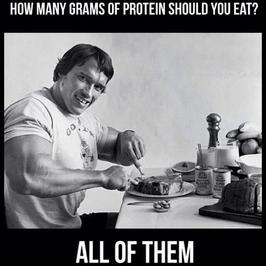
Here’s where you’ll have a range of answers, at the lightest end we can look at the Recommended Dietary Allowance (RDA), which stands at a measly 0.8 grams of protein per kilogram of body weight.
But that’s for an “average person”, and you’re not here because you want to be “average”, you’re here because you want to be even more awesome than you already are (with some extra muscle too).
So what does the research tell us?
One bodybuilding rune of thumb recommends eating at least 1 gram of protein per pound of body weight (or 2.2g per kilogram of body weight), so for a regular 180lb individual, this means eating 180 grams of protein per day.
Research from McMaster University doesn’t say wildly different. It states that 1.3 – 1.8 grams per kilogram of body weight (0.6-0.8 grams per pound of body weight) is sufficient to achieve maximum protein synthesis (i.e. muscle growth) [7].
Naturally, this is quite a range and could mean our typical 180lb individual is eating anywhere between 108 and 144 grams of protein per day. Unfortunately, there is no easy answer as, with many things in life, it depends on your situation.
If you’re serious about building muscle, there isn’t any reason to go below 0.8g of protein per pound of body weight, in fact, there isn’t much reason to go below the usual 1g of protein per pound of body weight, even going as high as 1.2g of protein per pound of body weight if you’re really having problems putting on mass.
Although if you’re eating more than 1.2g of protein per pound of body weight and are still struggling to put on muscle, it’s not your protein intake that’s the problem…
Depending on your activity level and your total calories, these figures can be bent slightly, for example, if you’re taking a few days off training, potentially you’re on holiday or are simply too busy with work, consuming the entire 1.2g of protein per lb of BW may not be worthwhile.
However, if you’re reducing your calories so much you’re in a caloric deficit (i.e. eating less than your body needs per day) eating even more protein can be really useful in maintaining muscle mass.
Oh, you’re worried about how more than 1.2g of protein per lb of BW will damage youre health? Unless you’ve got kidney disease…Don’t be worried, it wont damage your health [8]…
We’ve covered that protein is generally good, and that it’s pretty essential for not only growing, but maintaining muscle too. But what sources of protein should we be eating?
The ideal answer?
Meat & Fish.
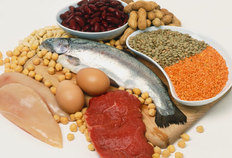
(…sorry vegetarians / vegans)
Sure, you can build muscle with a vegetarian and even a vegan diet, but unless you’ve got any specific dietary needs or can’t consume animals because the thought of baby cows going into the butchers makes you upset, good quality meat is your best bet.
Now here at Gainstopia, we’re not against eating vegetarian or even vegan, but when wanting to build muscle, meat is king. One of the reasons for this is that meat is a complete protein, i.e. has all the colors of amino acids to make the full protein rainbow, whilst many vegetarian and vegan sources of protein contain some, but not all, of the essential amino acids required to develop muscle most effectively [9].
Complete protein can be found within non-animal sources, some examples are chia, quinoa, buckwheat, hemp and Quorn. However, the levels of protein within these sources rarely compare per 100g compared to animal sources. Vegetarian forms of protein may hit a maximum of 15g protein/100g, whilst meat and fish sources can comfortably contain in excess of 25g of protein/100g.
Know any higher vegetarian sources of protein? Comment below. Thinking back to our typical individual looking to feast on a respectable 180g of protein a day, that’s a whole load of quinoa to eat at the dinner table, not to mention the high carb intake that typically comes from these sources. Of course, you can supplement with protein powder to boost your protein intake.
Back to meat and fish on the other hand and you have a great (super tasty) protein source which is no carb and higher in protein – excellent stuff for refueling your muscles after a heavy training session.
That concludes chapter 2 of Muscle Building 101.
Have you kept up so far? Great stuff, let’s complete this education.
3. Recovery
Recovery.
It’s not talked about much in training magazines or websites.
And it should be…

Recovery is much, much more than sitting on the sofa watching Netflix because your too lazy to go to the gym today. It should never be used as an excuse for letting your health fall down.
Time after time, we see people struggle with the concept of recovery, either they recover far too much (even going so far as training in January, then taking 11 months of “rest days”!), to recovering far too little.
In the case of recovering far too little, this is simply an issue where an individuals motivation far exceeds their knowledge of the body and it’s processes.
Typically you may see people wearing a stringer vest saying “Everyday is Chest Day”, sadly, some people take this seriously…But not to worry, you’ll soon be recovering like a professional in a couple of minutes.
As stated earlier, the body is an adaption machine. But this adaption is never instant.
- Just started running? You’re not going to be smashing out a sub-3 hour marathon the next day.
- Learning the piano? You’re not going to be Mozart in the afternoon if you first touched a piano in the morning.
And so it is with training…
- Just started at the gym? You’re not going to be squatting double your body-weight, flying through sets of 20 muscle-ups or competing in Mr Universe after 2 days.
I’m sorry if I’ve burst your bubble, but this isn’t going to happen after a “6 Week Transformation” people sign up for in January either.
”Rome wasn’t built in a day”, they say, and no other place is this more true with training and developing muscle. Timing is everything – so why do people think doing bench press every day will give them great results?
It’s understandable to think that more work = more results, so training a muscle more will make it grow faster? Right? Unfortunately not. The key here is to train smarter, not harder.One of the reasons for this is because of a little phrase called protein synthesis, which just means muscle repair or growth to me and you. It’s the process the muscles go through once they’ve been damaged and need to grow stronger. There’s a great video below on how this actually works:
So now you know the repairing of muscle isn’t an instant process, how long does each muscle take to recover? Following on from that, how often should I train each muscle for maximum muscle growth?
Unfortunately here, we have to walk through a bit of a grey area as the specific and optimal recovery time and training schedule and there’s a few things to consider;
- Have you trained this muscle before?
- Have you trained this muscle in this way before? (did you for example go from bench press to pectoral fly as your chest exercise?)
- Did you injure yourself at all during the session?
You should be thinking about these types of questions and more when planning what exercises you’ll be doing and when. If this is the first time you’ve stepped into the gym after a few months out, your recovery time will be longer. Similarly if you’ve tried a new exercise which tests the muscle in a new way, your recovery time will be longer.
Typically larger muscle groups take longer to recover so if you’ve just finished off some Gerrman Volume Training (GVT, 10 sets of 10) with squats, you should give yourself some extra time for your legs to heal and grow.
Fortunately, there is a variable which isn’t so erratic. The time where your muscles go through protein synthesis, i.e. how long do your muscles grow for?
The answer is at least 24 hours and up to 48 hours after exercise (including sleep) [10].
So bearing in mind that your muscle will be in a growth phase for up to 48 hours, it is sensible to train the muscle once again after this period. Personally I’ve implemented more calisthenics / body weight training into my regime which looks as follows:
- Monday – Yoga
- Tues – Pull Ups / Dips / Dead-lifts / Handstand Push Ups / Pistol Squats / Muscle Ups
- Weds – HIIT
- Thursday – Rest
- Friday – Pull Ups / Dips / Dead-lifts / Handstand Push Ups / Pistol Squats / Muscle Ups
- Saturday HIIT
- Sunday – Yoga
Essentially, my body weight resistance session typically occurs once every three days, whilst slotting in high intensity interval training and yoga in-between. However you could easily adopt a program like the following if you’re looking for maximal muscle growth:
- Day 1 – Push
- Day 2 – Pull
- Day 3 – Legs / Core
- Day 4 – Push
- Day 5 – Pull
- Day 6 – Legs / Core
- Day 7 – Rest / Yoga / Begin day 1 again if you’re feeling energetic!
Stretching after each heavy session will help your recovery process and minimize the risk of injury, ideally this will be after each session. Some yoga will give you further flexibility here too.
As ever listen to your body – if you’re not feeling 100%, feel free to take a rest day and then pick up where you left off.
A rest day isn’t going to hurt your progress, training too hard or injuring yourself definitely will.
So what’s the final piece of the puzzle with recovery, surely I can work a 20 hour day, do a few weights at the gym then take a 4 hours sleep and head back to work?
Though a little extreme (hopefully) this is example is seen far too frequently in those who work hard but also want to improve their physique. Working hard is something to be admired, boasting about how little sleep you get is not.
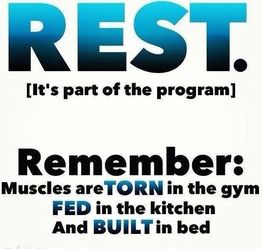
Sleep is an essential part of the recovery puzzle, miss out and you’re likely to be missing the full effects of protein synthesis (muscle growth).
This is already a fairly heavy duty article without going into too much detail about sleep – it’s so important that it should have its whole article which will hopefully be created before too long, in the meantime here’s a summary.
One of the most important reason for sleep is because Human Growth Hormone (HGH) rises during sleep [11].
HGH is responsible for a number of processes in the body, unsurprisingly, it’s responsible for the growth of tissue – great news for those wanting to pack on more muscle.
Other than boosting your HGH levels, sleep can also recharge your brain, help you make better food decisions the next day and even reduce your cortisol levels (cortisol is the “stress” hormone which is known to be catabolic / responsible for breaking down tissue).
But what if you find it difficult to sleep? There’s a couple of simple tips you can try to help stop you tossing and turning through the night:
- Stop looking at screens at least 1 hour before bedtime
- Try reading in bed
- Try meditating before bed
- Ensure your room is like a cave, cool, dark and silent.
- Avoid caffeine / alcohol
So there you have it, a 5 minute breakdown on the importance of recovery and how you can structure your recovery to ensure your body is in muscle growth phase as much as possible.
That concludes our third and final chapter of Muscle Building 101.
If you’ve got this far, well done, you’re now ready to ensure your time and efforts working out are not wasted!
Conclusion
We know that if you want to build muscle, it’s not quite as simple as picking up a dumbbell and throwing it around every day – there’s much more to consider, particularly as your body becomes used to training, you get older, or both!
Building muscle is often one of the key initial motivations for individuals starting to become healthier. Yet it is often so poorly misunderstood that many of us, including myself, don’t make the progress they want to initially.
So next time your wanting to build some muscle, always remember that there are three absolute essentials you need to think about before you putting on mass:
- Progressive Overload
- The Right Nutrition
- The Right Recovery
Follow this guide on the three absolute essentials and you will build muscle over time.
Nobody said it would be easy, nobody said it would be quick, but when it happens you know it’s worth it.
Know anyone who’s been trying to build muscle but hasn’t quite succeeded yet?
How about someone who thinks it’s OK to have 4 hours sleep a night?
Or someone who simply needs a bit of muscle building education…
Then why not share on Facebook? Share the wisdom! =)
References:
[1] High Reps, Low Reps? Which Rep Scheme Is Best? – http://www.bodybuilding.com/fun/high-reps-low-reps-which-rep-scheme-is-best.html[2] Your Ideal Rep Range – http://www.mensfitness.com/training/your-ideal-rep-range?page=2
[3] How to boost testosterone – http://www.mensfitness.co.uk/lifestyle/1558/10-ways-boost-testosterone
[4] What is the glycaemic index (GI)? – http://www.nhs.uk/chq/pages/1862.aspx?categoryid=51
[5] Trans Fats – http://www.heart.org/HEARTORG/GettingHealthy/NutritionCenter/HealthyEating/Trans-Fats_UCM_301120_Article.jsp#.VpVqf_mLTIU
[6] Everyone Was Wrong: Saturated Fat Can Be Good For You – http://greatist.com/health/saturated-fat-healthy
[7] Dietary protein for athletes: from requirements to optimum adaptation – http://www.ncbi.nlm.nih.gov/pubmed/22150425
[8] Do regular high protein diets have potential health risks on kidney function in athletes? – http://www.ncbi.nlm.nih.gov/pubmed/10722779
[9] Incomplete vs. Complete Proteins – http://www.fitday.com/fitness-articles/nutrition/proteins/incomplete-vs-complete-proteins.html
[10] Nutritional regulation of muscle protein synthesis with resistance exercise: strategies to enhance anabolism – http://easacademy.org/research-news/article/nutritional-regulation-of-muscle-protein-synthesis-with-resistance-exercise-strategies-to-enhance
[11] The Importance of Sleep! – http://www.bodybuilding.com/fun/drobson5.htm

